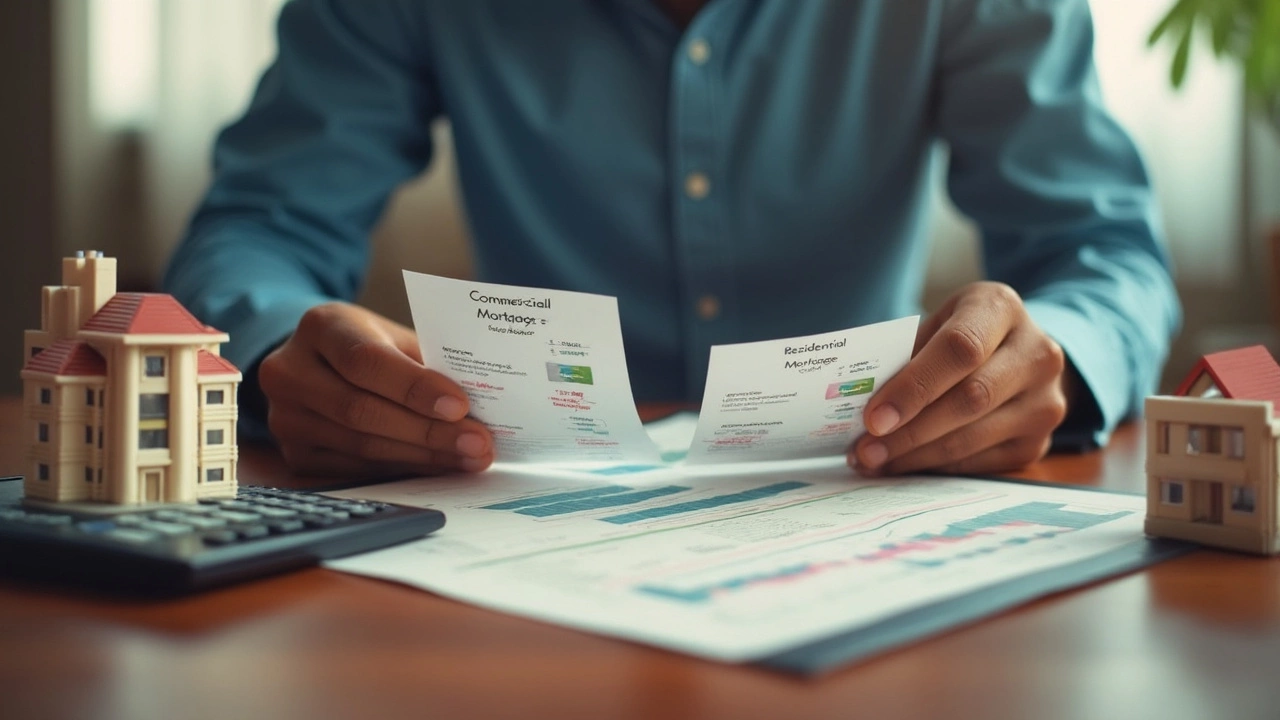If you’ve peeked at commercial mortgage rates lately, you probably noticed they run higher than residential rates. At first, it might feel unfair, but there’s real logic behind it—and some surprises. Banks and lenders just don’t treat business loans the same as home loans. Why?
To start, think about what’s on the line. With a home loan, lenders look at your job, your income, and your credit score. On the commercial side, the rules flip fast: now it’s all about the building’s potential to pay for itself and the ups and downs that come with running a business property.
Sound complicated? It kind of is. But once you know where banks see risk, how loan terms differ, and what pushes those rates up or down, it’s much easier to see what you’re really paying for. Plus, you’ll spot tips to boost your odds of landing a friendlier rate the next time you’re looking at a shopfront, warehouse, or office tower.
- Banks See More Risk with Commercial Properties
- Loan Terms: It’s a Whole Different Ballgame
- Market Demand Plays a Big Role
- What Influences Your Commercial Rate?
- Tips for Getting a Better Deal
Banks See More Risk with Commercial Properties
Banks don’t lose sleep over your house, but put a strip mall or apartment building on the line and things change fast. Here’s why: commercial properties swing more with the economy. If your retail tenants call it quits or your warehouse sits empty, lenders worry you’ll struggle to keep up with payments. That’s not the same with homes—people always need somewhere to live.
With commercial mortgage rates, lenders look hard at the property’s income and the businesses operating inside. The loan is only as good as that cash flow. If the tenants vanish or business slows down, so does the money backing the loan.
Let’s break it down. Homes have decades of reliable data—banks know how they perform. Commercial buildings? Totally different story. A single bad year or a popular tenant moving out can make or break the whole thing. That’s one reason banks usually require bigger down payments for commercial deals—often 25% or higher, compared to 10-20% for homes.
| Loan Type | Typical Down Payment | Avg. Interest Rate (April 2025) |
|---|---|---|
| Residential | 10-20% | 6.5%-7.2% |
| Commercial | 25%+ | 7.8%-9.0% |
Here’s another kicker—commercial properties take longer to sell. If a bank needs to repossess and offload a house, they have a big market full of families. But who’s out there waiting to snap up a struggling office complex? When something’s harder to sell, lenders build in extra buffers by raising commercial mortgage rates.
So when you see those higher numbers, it’s really just banks protecting themselves against a wilder, riskier investment.
Loan Terms: It’s a Whole Different Ballgame
People usually think of mortgages as these 30-year deals with predictable payments. That works for houses, but with commercial mortgage rates, it’s a whole new playbook. These loans rarely stretch to 30 years. Most run five to ten years, sometimes with a big payment waiting at the end, known as a balloon payment. That alone can make them riskier for everyone involved.
With business loans, lenders don’t assume the borrower wants to pay off the loan over decades. They expect businesses might sell, refinance, or change hands long before then. This short term setup gives banks less time to earn interest, so they charge higher rates to make up for it. There’s also usually a chunkier down payment—think 20% to 35% instead of the 5% you might see on a house.
It gets even trickier: the interest rate on a commercial mortgage often resets after just a few years. So you could start with one rate, but then get slapped with a new, sometimes higher one halfway through. Here’s a snapshot of the main differences you’ll see between the two:
| Feature | Commercial Mortgage | Residential Mortgage |
|---|---|---|
| Typical Loan Term | 5-10 years (often with balloon payment) | 15-30 years |
| Down Payment | 20-35% | 5-20% |
| Fixed Interest Period | Usually 3-10 years | Up to full length of loan |
| Rate Changes | Common (rate resets after a few years) | Less common (often fixed for entire loan) |
So, if you’re looking at commercial construction or buying a business property, pay attention to the loan details. A low starting rate might not last. Make sure you double check when your rate could adjust, and plan for that balloon payment. If you’re not ready when it hits, you could be stuck scrambling for a refinance at the worst possible moment.

Market Demand Plays a Big Role
When it comes to commercial mortgage rates, the back and forth of demand in the real estate world really changes the game. Lenders pay close attention to what’s hot and what’s not, way more than they do for homes. Say you’re eyeing a retail space in a busy urban center—if everyone wants in, banks know they can ask for a higher rate just because demand allows it. On the flip side, if offices are emptying out (think remote work trends), lenders might raise rates to offset risk or pull back on financing altogether.
Commercial real estate tends to ride the economic rollercoaster harder than residential markets. Business properties are closely tied to the strength of the local economy, job growth, and whether companies are expanding or shrinking. For example, after 2020, a ton of office buildings sat empty, and banks made it much tougher—and pricier—to borrow for those properties.
Here's another thing: supply and demand aren’t just buzzwords, they actually drive rates. Check out this simple comparison:
| Property Type | High Demand Years | Average Commercial Rate |
|---|---|---|
| Multifamily | 2021-2022 | 4.0% - 4.5% |
| Retail | 2018-2019 | 4.7% - 5.2% |
| Office | 2016-2018 | 4.3% - 5.1% |
This uptick isn’t banks being greedy—it’s really about hedging their bets. If everyone wants to buy warehouse spaces for e-commerce, lenders know those loans are safer so the rates press a little higher compared to sectors in a slump. But if a sector looks shaky, like smaller malls or strip centers lately, rates can go up because banks expect more headaches down the road.
For anyone eyeing a business property, this means staying alert to trends in your local market. Watch which sectors have rising demand, and time your loan applications around economic cycles if you can. Going for a property everyone wants will almost always mean a stiffer commercial mortgage rate.
What Influences Your Commercial Rate?
When you’re hunting for a commercial mortgage rate, the number you land on isn’t just pulled out of thin air. There are a bunch of moving parts that shape the final offer.
Property type is a big factor. Office buildings, warehouses, and retail shops all live in different risk zones for lenders. An apartment building might get a lower rate than a vacant strip mall just because lenders think it’s easier to fill apartments than retail space.
The location matters too—prime downtown spots get more love than properties in struggling neighborhoods. If it’s hard to resell or rent out, lenders get nervous, and up goes your rate.
Next, loan-to-value ratio (LTV) comes in. If you’re only putting 10% down, the bank's taking on more risk. Dropping more cash up front, maybe closer to 30% or 40%, can bump that rate down a notch.
Another biggie: business financials. If your business brings in steady cash, you’re less risky. Lenders pick apart your financial statements, tax returns, and debt history before quoting a rate. Got big profits and low debt? You’re in a stronger spot.
Then there’s the loan term itself. Most commercial mortgage rates come with shorter terms—often five to ten years with a big balloon payment. Shorter terms usually mean higher monthly rates compared to those friendly 30-year home loans.
To see how these factors stack up, here’s a quick breakdown of typical influences on a commercial mortgage rate:
- Creditworthiness of both business and owners
- Property’s current income and occupancy
- Industry type (some, like hospitality, are just riskier)
- Prevailing market rates and the economy’s health
- Down payment size (lower LTV is better)
Rates also have a connection to broader market trends. For example, after early 2022, the Federal Reserve kept pushing up base rates to fight inflation, and commercial mortgage rates jumped in response.
| Factor | Effect on Rate |
|---|---|
| Location | Prime = Lower Rate, Struggling Market = Higher Rate |
| Property Type | Multifamily = Lower, Hospitality = Higher |
| LTV Ratio | Lower LTV = Lower Rate |
| Business Strength | Steady Profits = Lower Rate |
| Loan Term | Shorter = Higher Rate |
So, if you want a friendlier commercial mortgage rate, it all starts with a solid property, healthy business, and putting more money down if you can swing it.

Tips for Getting a Better Deal
If you’re shopping around for a commercial mortgage rate, don’t settle for the first offer you get. Lenders size you up based on facts and numbers, and you can control more of those numbers than you think.
- Boost Your Down Payment: Lenders take you more seriously when you put more skin in the game. Shooting for 25% or even 30% down can open doors to a lower rate. Some banks flat-out require this for their best commercial mortgage rates.
- Polish Your Financials: Have clean, up-to-date records—think tax returns, business profit-and-loss statements, and a current rent roll for the property. The more organized and transparent you are, the less risky you look. This can nudge your rate down.
- Shop and Negotiate: Don’t assume all banks play by the same rules. Get quotes from different lenders, including credit unions and commercial mortgage brokers. If you get a better offer elsewhere, use it to negotiate.
- Check Your Personal and Business Credit: Both your personal and business credit scores matter. If you have a solid credit score (think 700+), lenders feel better about lending. Clean up any issues before you apply.
- Consider the Property Type: Lenders see certain property types as less risky—like multi-family apartments—compared to specialized spots like gas stations or restaurants. If possible, aim for properties that are “mainstream.”
According to a 2024 survey from the Mortgage Bankers Association, borrowers who got quotes from at least three lenders saved an average of 0.37% on their commercial mortgage rate compared to those who stuck with just one offer. Doesn’t sound like much? On a $1 million loan, that’s a difference of $3,700 every single year.
| Down Payment | Estimated Rate (%) |
|---|---|
| 20% | 8.25 |
| 25% | 7.95 |
| 30% | 7.40 |
Look at that range. Just bumping your down payment from 20% to 30% can save you thousands in interest over the life of the loan.
Finally, don’t forget closing costs. Sometimes a lender advertises a low rate but packs in higher fees. Always ask for a breakdown of all the charges. The real “deal” might be the all-in cost, not just the interest rate.
